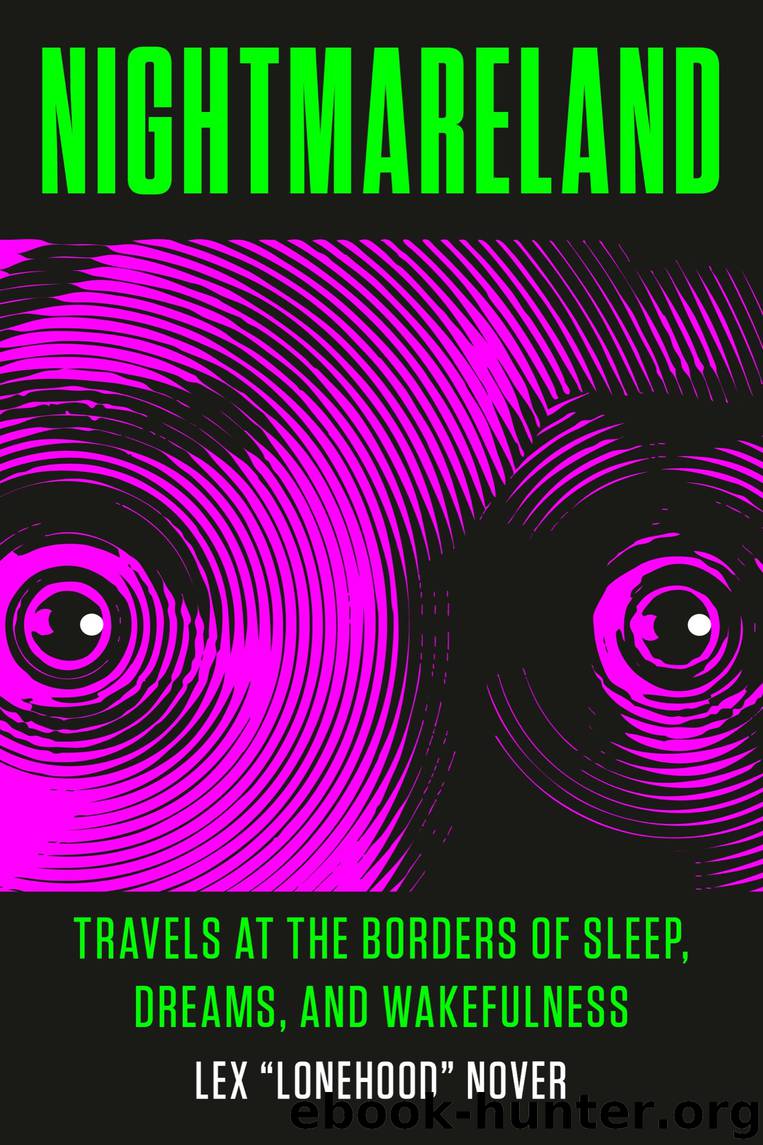Nightmareland by Lex Lonehood Nover

Author:Lex Lonehood Nover
Language: eng
Format: epub
Publisher: Penguin Publishing Group
Published: 2019-10-07T16:00:00+00:00
THE BRAIN AT THE THRESHOLD
Mavromatis divided hypnagogia into stages moving from lighter to deeper. On the deeper end of the pool, as a person nears the submergence of sleep they block out more of the waking world.
The hypnagogic state brings its own bumpy set of brain waves. But first, a bit about brain waves in general. Their patterns, as measured by an EEG, represent the synchronized electrical firings of billions of neurons ricocheting in our head at any one time (if somehow all the electricity in the brain could be harnessed it could fully charge an iPhone in around sixty-eight hours49—OK, so, no rush to get a USB connector installed in the back of your head). During our waking hours, beta waves tend to dominate for such activities as critical thinking, problem solving, and reading; the slower alpha waves promote relaxation and are the bridge between beta and theta. Prominent during sleep, meditation, and daydreaming, theta waves oscillate when we’re disengaged from the world.
Hypnagogia is marked by the transition out of beta into grappling cycles of alpha and theta, and even an EEG grab bag of “humps, spikes, or partial spindles.”50 As we move toward sleep from the relaxation of alpha to the drowsiness of theta, neither brain wave maintains dominance, and this contributes to the “half-asleep” or “half-awake” scenario.51 During these vacillations, the brain’s domineering left hemisphere also loses jurisdiction, and more fluid associations take place (the subject of enhanced creativity in this state, coming up shortly).
Mavromatis proposes that hypnagogia arises from structures like the thalamus in the “old brain” that hold sway when the neocortex (a more recent evolutionary development) is suppressed. The fact that we’re getting a glimpse of the consciousness of our “old brain” while still retaining some function of the “new brain” is why hypnagogic imagery and sensations may seem so unfamiliar to us.52
Further, just as the stars are always in the sky but hidden from our view during daylight, Mavromatis suggests that the brain structures responsible for hypnagogic phenomena are always active, but their handiwork is blotted out by the neocortex and its focus on the external world. This parallels Rudolf Steiner’s idea, Lachman notes, that the “astral world” is always with us but our ability to perceive it is blocked by ordinary consciousness.53
Located in the thalamus, deep inside the center of the brain, is the mysterious pineal gland, which Descartes regarded as the seat of the soul. Some have speculated that the tiny organ releases DMT (a hallucinogenic substance dubbed the “spirit molecule” by Dr. Rick Strassman) at certain times, and if so, it could be a factor in the trippiness of the hypnagogic experience.
Download
This site does not store any files on its server. We only index and link to content provided by other sites. Please contact the content providers to delete copyright contents if any and email us, we'll remove relevant links or contents immediately.
| Ancient & Controversial Knowledge | Ghosts & Hauntings |
| Hermetism & Rosicrucianism | Magic Studies |
| Occultism | Parapsychology |
| Supernatural | UFOs |
| Unexplained Mysteries |
Animal Frequency by Melissa Alvarez(3755)
Sigil Witchery by Laura Tempest Zakroff(3653)
Real Magic by Dean Radin PhD(3569)
Fingerprints of the Gods by Graham Hancock(3216)
The Rosicrucians by Christopher McIntosh(3051)
Aleister Crowley: The Biography by Tobias Churton(3021)
Journeys Out of the Body by Robert Monroe(2988)
Alchemy and Alchemists by C. J. S. Thompson(2913)
Mysteries by Colin Wilson(2886)
Hitler's Monsters by Eric Kurlander(2734)
John Dee and the Empire of Angels by Jason Louv(2712)
Wicca: a guide for the solitary practitioner by Scott Cunningham(2706)
Infinite Energy Technologies by Finley Eversole(2492)
The Hatha Yoga Pradipika (Translated) by Svatmarama(2487)
Dark Star Rising by Gary Lachman(2422)
The Book of Lies by Aleister Crowley(2384)
Aliens by Jim Al-Khalili(2383)
To Light a Sacred Flame by Silver RavenWolf(2355)
Hitler's Flying Saucers: A Guide to German Flying Discs of the Second World War by Stevens Henry(2297)
